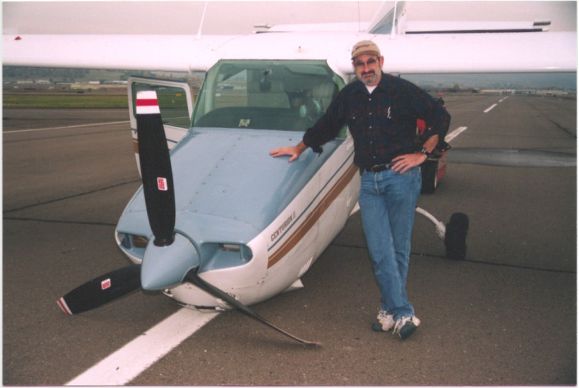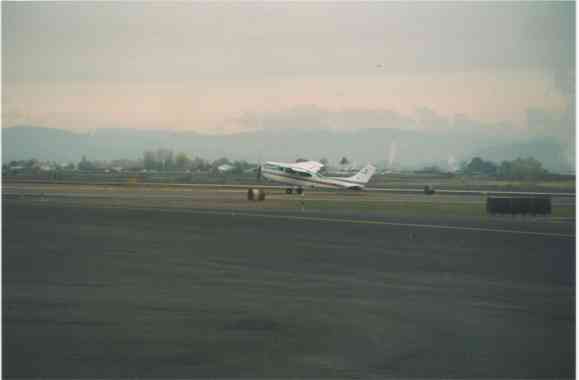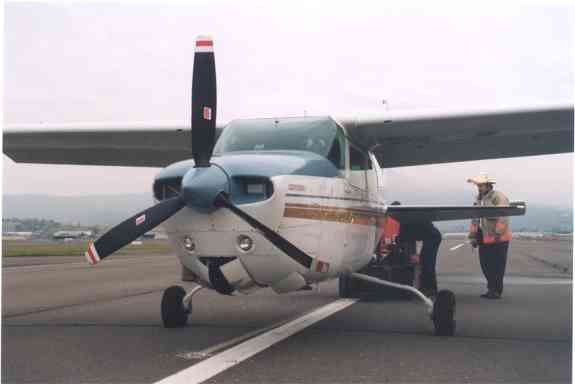ENGINEERING
This Web Page: SV STORIES
|
ENGINEERING |
||||
|
This Web Page: SV STORIES |
||||
| CONTACT RAS |
|
SILICON VALLEY STORIES This web page will be devoted to stories about the involvement of RAS in products and projects generated in Silicon Valley where RAS was either actually involved in the project, had very close personal friends who were part of the project or both. There are a lot of stories to choose from. Some of the companies that are the source of these stories are; Fairchild, National Semiconductor, IBM, Hewlett Packard, Seagate, Quantum, Abbott Labs and many, many more. However the first story is not about a company at all, but it is a rather unusual tale. It is the story of landing my aircraft with no deployed nose wheel. Other stories that are planned are as follows: 1.0 The FIRST PROGRAMMABLE VIDEO GAME with cartridges and hand controllers. The above stories will be a good start. |

N68TB
PROP STRIKE IN MEDFORD NOV 9, 1998
AIRCRAFT TYPE: T210N
By Ron Smith
What is a T210N?
For those unfamiliar with general aviation aircraft a T210N is a single engine Cessna. The "T" refers to turbo and the "N" refers to the model ("N" models were built from 1979 thru 1984). This aircraft happens to be a 1981. It is typically referred to as a high performance single because it has a turbo charged fuel injected 310 hp engine, retractable landing gear and a propeller that will change pitch automatically when power is changed to maintain a constant RPM (thus the term "constant speed" prop). It will climb to over 20,000 ft. It has a tremendous load carrying capability (the rule of thumb is that if you can get the doors closed it will get off the ground). It will carry over 1100 lbs(6 people + luggage) after putting 534 lbs of fuel aboard. I have owned the aircraft for over 12 years and it was the perfect airplane for me and it still is.
What happened?
I was on a flight from SJC (San Jose International, California) to MFR (Medford, Oregon). I took off from SJC (my home base) at about 11:00 am Monday morning. It was a VFR flight. My intended route of flight was SJC - RBL - Ft JONES - MFR. I climbed out of SJC talking to Bay Approach and was cleared to climb to my cruising altitude of 12,500 ft. The temperature at 12,500 was 18 degrees F. The engine was running perfectly and I maintained a steady climb to altitude. Skies were clear and visibility was unrestricted.
I noticed that the #6 GEM (this instrument displays individual cylinder termperatures) read out was inop and so was the ships CHT gage (cylinder head temperature). I maintained a constant 30 in MP (intake manifold pressure) and 1530 on the TIT (turbine inlet temperature). At 12,500 I went on oxygen. After passing RBL on V23 I noticed some scattered clouds over the mountains below and a high over cast above. I climbed to 14,500 with no problem. At about 23 miles from Ft Jones I called Seattle Center and requested IFR to MFR. I was given a squawk and a clearence almost immediately to 14,000.
Some time later I noticed that everything was pretty quiet and I would have to be coming down pretty soon so I decided to call center. I got no response in my head phones upon depressing the PTT button (push to talk). I rechecked the switches and realized I had miselected a switch. I called Seattle again. They immediately responded, cleared me down to 10,000 and handed me off to Cascade Approach. Since I was quite high I deployed the gear to act as a speed brake since I did not want to reduce MP because I am breaking in the engine which only had .2 hrs on it prior to this flight from the short flight flown Sunday the day after it was completed. I did not notice the gear down indicator at this time and the gear up warning did not activate because I had over 15 in MP. I retracted the gear again at 10,000 and proceeded normally. Cascade cleared me to 8,000 and then to 5,100 on a heading of 325.
I then was turned right to 110 and cleared for the approach. I intercepted the localizer and turned inbound to 140 as the needle centered. Then Cascade handed me to the tower. I called up the tower and was told to report the OM(a radio beacon). I was cleared to land on 14 (this is the runway identification, 14 means the direction of the runway is close to 140 degrees) before reaching the OM. I extended the gear and went through the GUMP check list (Gas, undercarriage, mixture, prop). I had felt the gear lock and everything appeared normal and I donít remember noticing the gear down lock light. I was now over the threshold an started to pull the power all the way back. Now the gear warning horn started going off. I now started looking around and noticed the gear down and locked indicator was not lit. I decided to do a go around. I applied power and started the go around. I also contacted the tower and told them what I was doing. I told them I lacked a gear down indication and they confirmed that they did not see the front gear extended. I went around and recycled the gear several times and could not get a gear down light. I went by the tower again and they took another look. They confirmed each time that the nose gear was still retracted. My next comment to the tower was, "I hate it when it does this!"
About this time I knew that I would have to land the aircraft with no nose wheel and there goes a factory new remanufactured engine. They had just finished putting this engine in the A/C (aircraft) and it is running perfectly. I also had them do an annual since it was down anyway. This is the engine that I have always wanted. I really recommend the GAMI fuel injectors. This is its second flight. The first one was yesterday (Sunday). I took the plane out to do a high power break-in run, but weather forced a quick return to SJC. The gear worked fine. Now I am about to land on the nose which will require a new prop, an engine prop strike inspection at minimum and a bunch of sheet metal work.. The A/C already has been down a couple of months and here we go again.
I was given a clearance to go over to the west side of the field and try to get the gear to extend. I recycled continually. I tried diving and pulling up as hard as I could. I caused accelerated stall conditions because of the pull outs. I did this and tried extending the gear at the same time. Nothing worked. The tower contacted a 210 mechanic and they suggested pulling up and applying hard rudder at the same time. I did this several times and almost got sick and just about put the plane on its back.
I contacted the tower and suggested that I bounce it hard on the mains. I was cleared for the approach. I slowed to about 60 to 70 knots, maintained a nose up attitude, descended to maybe 50 ft over 32 and pulled the power back. The 210 came down real hard on the mains. As I bounced back into the air I applied power again. No luck, the front gear was still stuck retracted.
When I arrived at Medford I had about half tanks and now I had about 25 to 30 gallons. I decided I wanted to land the plane while I still had plenty of fuel left. I was most worried about doing damage to the airplane. I was never concerned about getting hurt. I really didnít see how it was possible to get hurt. The goal was to land totally power off and the prop going as slow as possible before the nose lowered to the ground. The prop was going to be destroyed no matter what.
When I told the tower that I was ready to land this thing, they asked if I would mind taking runway 27. I realized that they wanted to prevent blockage of runway 32 if possible. I had no problem with that and in fact agreed with them. On the down wind leg I made sure the harness was snug and there were no loose objects that might injure me if they were flying around the cabin. I lined up on 27 and made a slow approach, but as I got close I didnít feel comfortable with my energy condition and the position I was in. I had turned in too close and didnít have enough time to get comfortable with this final approach so I requested a go around. This time around I extended the down wind leg and turned inbound for a long final. I set up for about 60 knots. The tower asked if I could land past 32 if possible, but quickly said that whatever I decided is what they would go with. I didnít see any problem with that. I was close to the threshold of 27 and started a decent. I had it made now so I turned everything off including ignition. I then realized I might land short and end up in the middle of 32 thus blocking it so I hit the ignition again and the engine immediately came to life. I added just a little power and then turned it off again.

This is N68TB actually landing with no nose gear
I gently descended to the runway and I donít really remember actually touching down. I kept the stick all the way back and didnít even consider hitting the brakes which of course would send the plane on its nose immediately. The plane rolled along slowing down with the nose in the air. It was like slow motion. Finally I was getting very slow and I knew the nose was going over.
The nose gently lowered, the prop stopped and I slid for a few feet. I hardly felt any bump at all. I had already turned everything off so all I had to do was open the door. When I opened the door and put my foot out, I immediately felt pavement. This was a very wierd sensation. As I got out a fireman came over and wanted to disconnect the battery. I told him where it was and we would first have to take the cowl off on the left side. I asked if he had a phillips head screw driver. He didnít so I got mine out of the baggage compartment. The tail was high in the air and I could barely reach it, but I retrieved it and decowled the left side. We disconnected the battery. I noticed my hand was shaking when I was undoing the cowl fasteners.
I stepped back and got a good look at the aircraft to survey damage. The prop had stopped with one blade vertical. It was slightly bent, but the other two tucked under the lower cowl were bent quite a bit more. By this time there were quite a few people around the plane taking pictures inside and out. The firemen were making sure everything was off and then they asked me if I wanted to go to the hospital and I asked, "What for?" They required me to sign a document saying that I had refused medical aid.
Then I was asked where I wanted the aircraft towed when the FAA released it from the runway. I told them to take it to the Jet Center. About this time I really started to look the plane over. You could see that I had gone straight down the middle of the runway. The exhaust stack had scrapped the paint from the centerline. Many people came over and commended me for a great landing. Actually it was just like a normal landing except for the last 10 to 15 seconds when the nose hit the runway. Other than the exhaust stack and the gear doors I could see little external damage.

Now the Jet Center personnel showed up and attached a line to the rear tie down and pulled the tail down raising the nose. The front gear came partially out, but still did not come down. I think they pumped it down finally and you could hear and see it lock.
Next I was asked if I would grant an interview with the media. I looked over and there were three camera crews out in front of the Jet Center. My next response was, " Boy, things must be slow in Medford." I went over and we had a 5 to 10 minute interview. After the interview I was greeted by the Airport Authority. He told me I needed to call someone at FSDO which I did immediately. He informed me to call the NTSB. I told him that I would do that first thing the next day. They hangered the aircraft but couldnít do anything with it until the FAA saw it which would be in a day or so.
THE NEXT DAY
I called the NTSB and got handed off to someone that said that they knew about the activities in Medford concerning my A/C and that this was going to be classified as an incident and not an accident because the damage to the A/C was minor. This was good news. This incident was eventually ruled "not pilot's fault" which made me feel pretty good and relieved. As a pilot you could not do this even if you wanted to because one lever causes all landing gear to deploy or retract.
There were a lot of pictures of this landing because I was circling around for quite a while talking to the tower and this gave the media and the airport photographer time to get to the airport to witness the whole thing. The photos presented here were sent to me by the airport photographer.
The aircraft was repaired in Medford at the Jet Center and I liked them to the extent that I have been doing my annuals there ever since. It took about 6 months to get the aircraft back in service, but I must say it is really flying great and it is in the best shape it has ever been in.
| © COPYRIGHT 2001 RONALD A SMITH AND ASSOCIATES INC. ALL RIGHTS RESERVED |